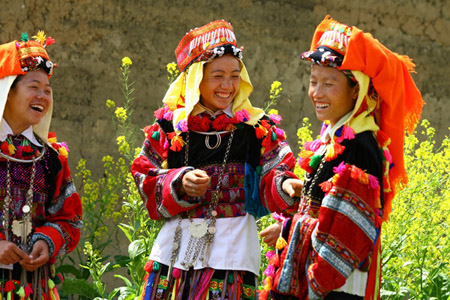According to the 1999 census, the majority Kinh (or Viet) people of Vietnam account for some 86.2 percent of the total population of just over 84 million people. The remaining 13.8 percent is made up of 53 culturally distinct ethnic minority groups, each with its own rich cultures and traditions. Both the Kinh people and the country's 53 ethnic minority groups derive from three great language families - the Austro-Asiatic, the Austro-Thai, and the Sino-Tibetan.
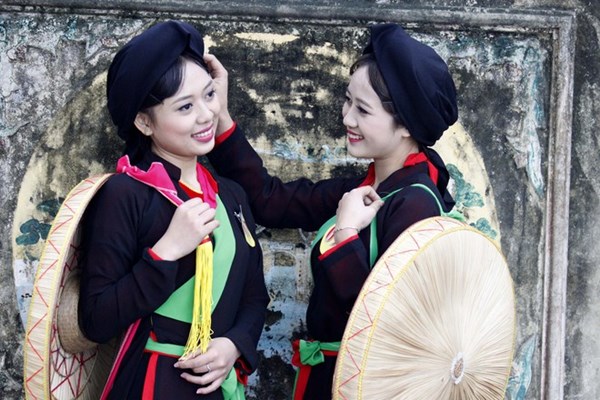
The majority Viet language (tieng Viet) is one of approximately 150 languages belonging to the Austro-Asiatic language family. However, the classification of tieng Viet and its upland counterpart Muong within that language family is still the subject of academic debate - some scholars argue that it should be classified as part of the Mon-Khmer language sub-family, while others (including most Vietnamese linguists) maintain that it should be categorized as a separate language sub-family within Austro-Asiatic, on the same level as Mon-Khmer, Asli, Munda, and Nicobar.
The Viet-Muong language sub-family/group is dominated by the Viet (or Kinh), who constitute Vietnam's ethnic majority, and their upland cousins the Muong, Vietnam's fourth-largest ethnicity, who reside mainly in Hoa Binh Province to the west of Hanoi. The Tho of Nghe An and Thanh Hoa provinces south of Hanoi and the Chut of Quang Binh province in central Vietnam also hail from this ethnicity.
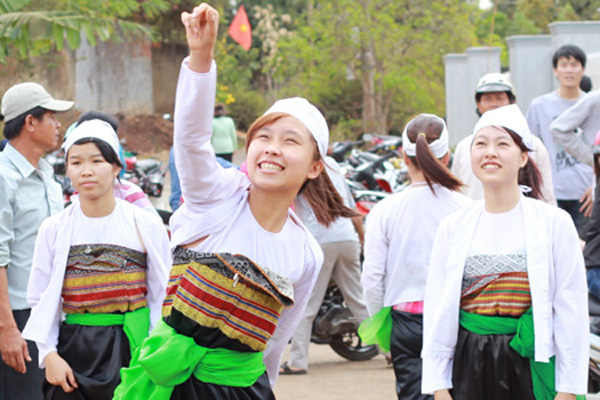
Branches of the Mon-Khmer language sub-family represented in Vietnam include Eastern Mon- Khmer (Kho-me), Bahnar (Ba-na, Brau, Gie-Trieng, Cho-ro, Co-ho, Hre, Ma, Sre-Mnong, Ro-mam, Xo- dang and Xtieng), Katu (Bru-Van Kieu, Ca-tu, Ta-oi), Khmu (Khang, Kho-mu, O-du, Xinh-mun) and Mang (Mang). The Kho-me (equivalent to the Khmer of Cambodia) constitute the sixth-largest ethnic people in the country and are widely settled throughout the Mekong Delta provinces of the south. The great majority of the other Mon-Khmer ethnicities are settled in the central and southern-central highlands region bordering Cambodia and southern Laos; notable exceptions to this rule are the Kho-mu, Khang, Mang, and Xinh-mun, all of whom reside in the mountainous North West.
Three language sub-families of Austro-Thai are represented in Vietnam - Austronesian (Malay- Polynesian), Hmong-Mien, and Tai-Kadai.
The Austronesian or Malay-Polynesian language sub-family is represented by five of Vietnam's ethnic minority groups - the Cham, the Chu-ru, the E-de, the Gia-rai, and the Ra-glai - all of whom hail from a Sundic sub-branch of Achinese-Chamic and are to be found in south-central Vietnam. Perhaps best-known of these are the Cham, now settled in the southern coastal provinces of Binh Thuan, Ninh Thuan, Khanh Hoa, Phu Yen, and Binh Dinh, whose ancestors founded the ancient kingdom of Champa. However, more numerous today are their neighbors the Ra-glai and the Chu-ru, and their central highland cousins the E-de of Dac Lac province and the Gia-rai of Gia Lai and Kon Turn.
Hmong-Mien language speakers are believed to have migrated from southern China into Vietnam, Laos, and northern Thailand only over the last 300 years, and in Vietnam, all representatives of the two constituent Hmong-Mien language groups, Hmong (Miao) and Mien (Yao), are settled exclusively in the north of the country.
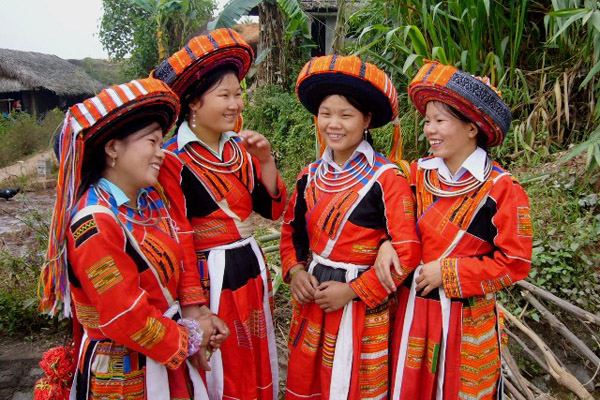
The Hmong (Miao) language group is made up of four separate branches, three of which are represented in Vietnam. These are the Chuanqiandian branch, which incorporates the White Hmong (Hmong trang) and the Flower or Variegated Hmong (Hmong hoa); the Qiandong branch, which includes the Black Hmong (H'mong den); and the Xiangxi branch, which embraces the Red Hmong (Hmong do).
The Mien (Yao) group is represented in Vietnam by the Dao (Yao) ethnic minority, whose members are drawn from either the Mien Yao or the Mun Yao language branches. Mien Yao communities in Vietnam include Black Dao (Im Mien), Red Dao (Im Mien, Kim Mien, Kiem Mien), Coin Dao (Kem Mien, Kam Mien), Dao Ta Pan (Kim Mien), and Dao LO Gang (LO Gang), while Mun Yao communities include Dao Lan Tien (Kim Mun) and White-trousered Dao (Kim Meun).
The Hmong and the Dao are Vietnam’s eighth and ninth-largest ethnic groups respectively. The H'mong are settled widely across the north of the country but particularly in Son La, Dien Bien, Lai Chau, Lao Cai, Tuyen Quang, Yen Bai, Ha Giang, and Cao Bang Provinces. The Dao is also found widely throughout the mountainous north of Vietnam, with major pockets of settlement in Hoa Binh, Son La, Dien Bien, Lai Chau, Lao Cai, Tuyen Quang, Thai Nguyen, Yen Bai, Ha Giang, Bac Can, Cao Bang, and Lang Son Provinces.
The Tai-Kadai language sub-family comprises two language groups - Kadai or Kam-Tai (Co Lao, La Chi, La Ha, and Pu Peo) and Tay-Thai (Bo Y, Giay, Lao, Lu, Nung, San Chay, Tay, and Black/White Thai). Common ancestors of both groups are known to have migrated from southern China in large numbers during the first millennium CE. Some traveled as far as modern-day Laos and Thailand, where they went on to lay the foundations for the powerful kingdoms of Lan Xang (Tay-Thai) and Sukhothai (Kadai), while others chose to settle en route in the northern mountains of Vietnam. Today the Tay (north and northeast Vietnam), the Black and White Thai (northwest Vietnam), and the Nung (north and northeast Vietnam) constitute respectively the second, third and seventh largest ethnic groups in the country after the Kinh.
The Sino-Tibetan language family in Vietnam is represented by two sub-families. The Han (Sinitic) subfamily incorporates the Yunnan’s (southwest Mandarin)-speaking Hoa, Ngai, and San Diu ethnicities; while the Lolo-Burmish subfamily incorporates the Lolo-speaking cong, Ha Nhi, La Hu, Lo Lo, Phu La, and Si La ethnicities. The Hoa or ethnic Chinese constitute Vietnam’s fifth largest ethnic group, who are nowadays found mainly in Ho Chi Minh City and the surrounding Mekong Delta provinces, though scattered rural Hoa settlements may also be found in many other parts of the country. All other Sino- Tibetan ethnicities are settled exclusively in the north of Vietnam.
Other ethnic groups in Vietnam include a tiny Indian community in Ho Chi Minh City and a small but growing western expatriate population in both Hanoi and Ho Chi Minh City.
At present, there are 54 different ethnic groups inhabiting Vietnam, in which Kinh (Viet) people make up nearly 90% of the whole population, and 53 other ethnic groups represent over 10%.
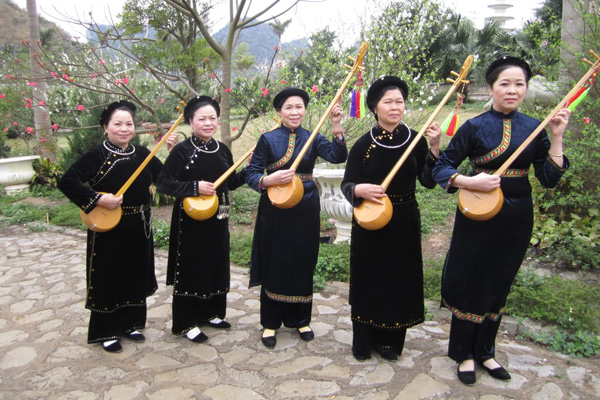
The Vietnamese nation was formed through a process of two major ancient cultures, the Chinese and the Indian. Thus a peculiar trait of Vietnam's culture was formed. As far as anthropology is concerned the Vietnamese people have their origin in the Mongolid race, believed to be one of the major or races of the world and often found in northern and eastern Asia.
* 54 different ethnic groups inhabiting Vietnam can divide eight different groups by the Vietnamese language:
- The Viet - Muong Group includes 4 ethnic groups: Chut, Kinh, Muong, Tho.
- The Tay - Thai Group includes 8 ethnic groups: Bo Y, Giay, Lao, Lu, Nung, San Chay, Tay, Thai.
- The Mon - Khmer Group includes 21 ethnic groups: Ba Na, Brau, Bru-Van Kieu, Cho Ro, Co, Co Ho, Co Tu, Gie Trieng, Hre, Khang, Khmer, Kho Mu, Ma, Mang, M'nong, O Du, Ro Mam, Ta Oi, Xinh Mun, Xo Dang,
- The Mong - Dao Group includes 3 groups: Dao, Mong, Pa Then.Vietnam_ethnic_Hmong
- The Kadai Group includes 4 ethnic groups: Co Lao, La Chi, La Ha, Pu Peo.
- The Nam Dao Group includes 5 ethnic groups: Cham, Chu Ru, Ede, Gia Rai, Raglai.
- The Han Group includes 3 ethnic groups: Hoa, Ngai, San Diu.
- The Tang Group includes 6 ethnic groups: Cong, Ha Nhi, La Hu, Lo Lo, Phu La, Si La.
In the core of the history of national development, all these groups of people have been closely attached to one another in sharing the same tasks of fighting against foreign invaders, defending the country's territory, gaining the right to live, and the right to national independence and self-determination. Each group of ethnic people has developed their own language and identity, thus making the Vietnamese culture, long known for its variety, a well-blended combination of different cultures.

